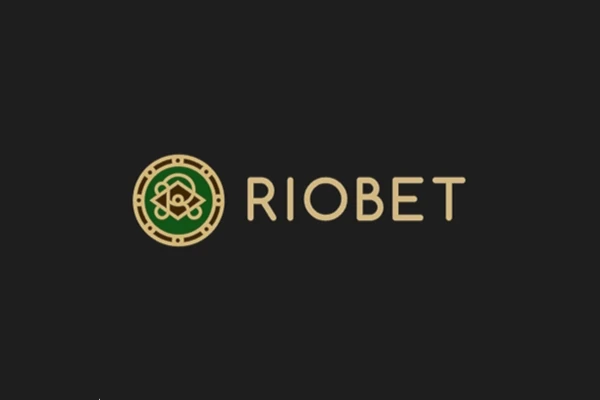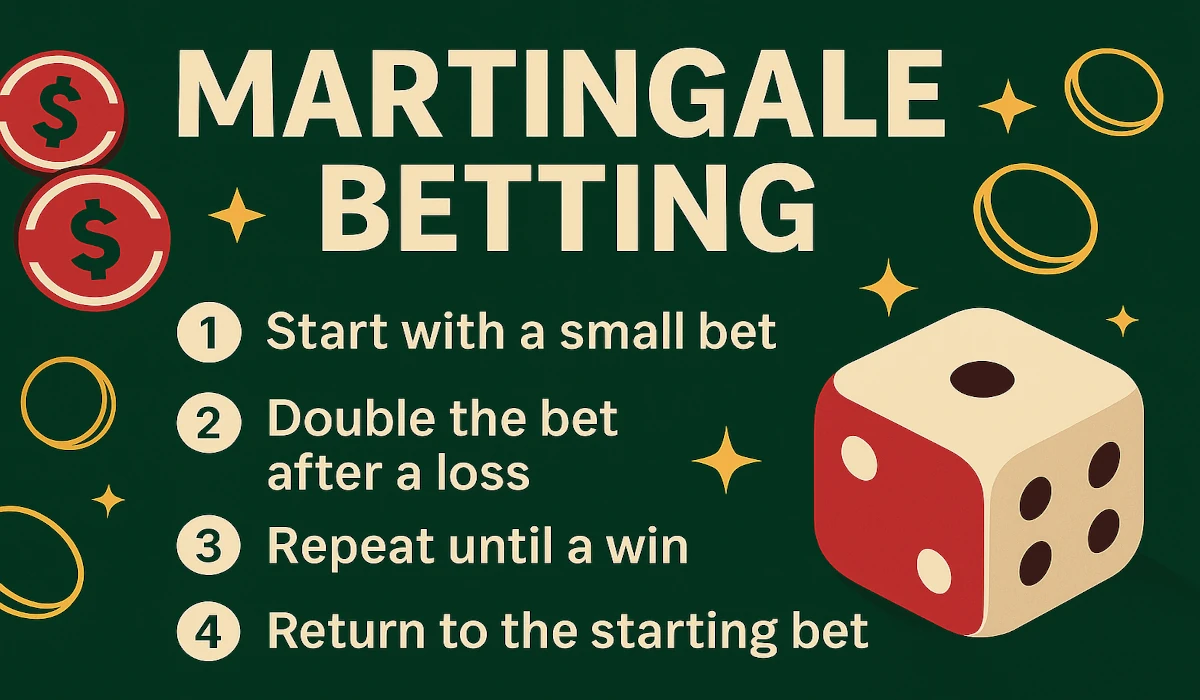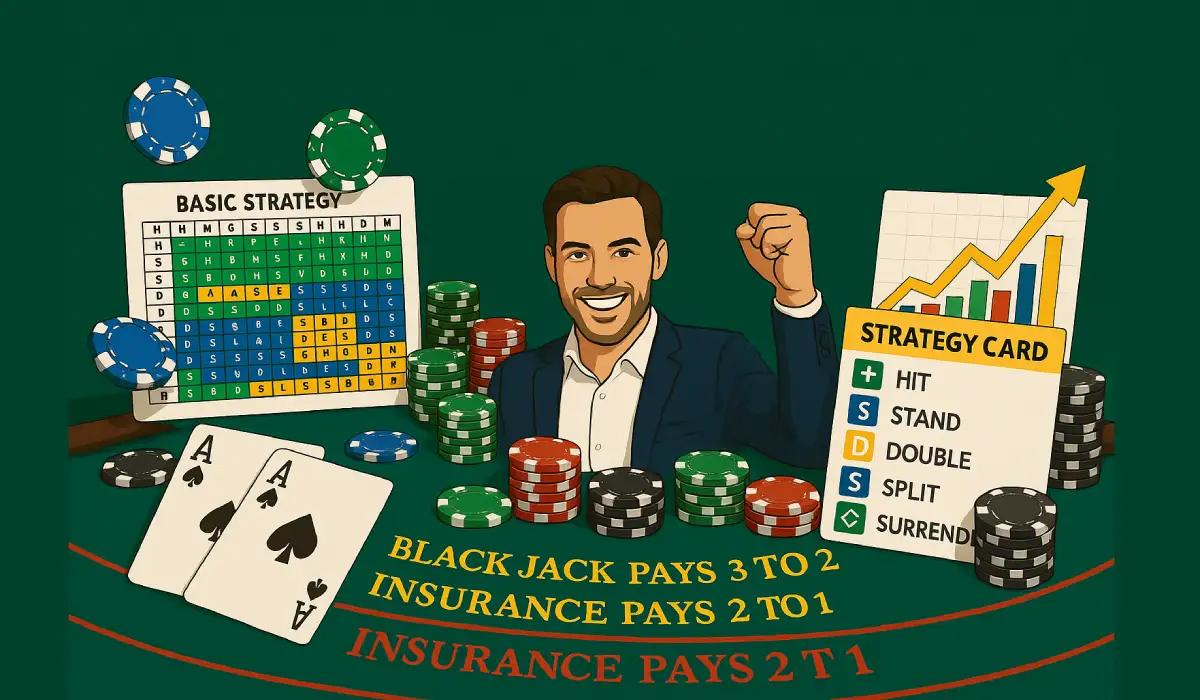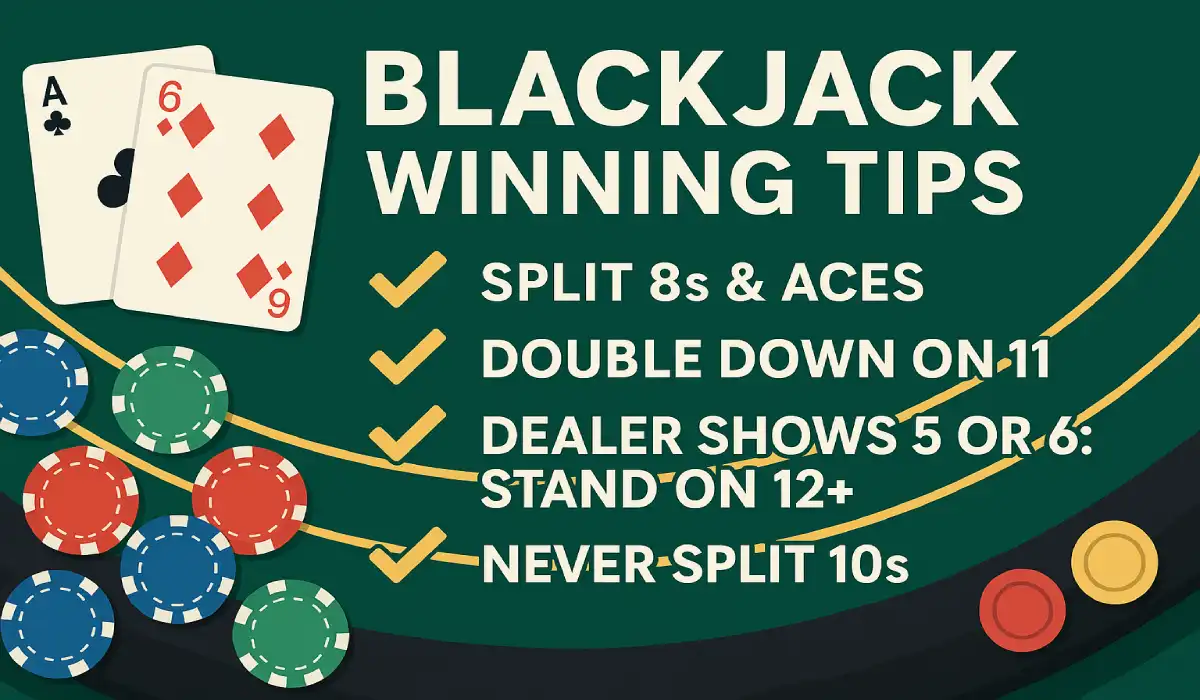.webp)
14 Jun 2025
Blackjack Chart: Comprehensive Guide to Blackjack Strategy
🗝️ Key Takeaways
- In case you aren’t familiar with a blackjack chart, it’s an organized color-coded chart that provides suggested actions for different hand totals and dealer’s upcard, helping to demystify the process of playing basic strategy.
- Knowing the math behind blackjack charts, like probability and expected value, can help you make informed decisions during the game.
- It’s important that you understand how to read and interpret a blackjack chart, such as identifying hand types and the chart’s legend, to play correctly and avoid errors.
- By customizing strategy to different chart variations, number of decks, and particular rules, such as dealer’s soft 17 or surrender, players are better equipped to react to different game conditions.
- Advanced strategies including pair splitting, doubling down, and insurance bets can offer further advantage when paired with basic chart knowledge and practice.
- Not making stupid mistakes, like disregarding the chart or blindly following it, is essential. Regularly combining chart advice with your own insight produces more consistent, winning results.
A blackjack chart is a map of every move you should make for every potential hand. Players consult these charts to determine whether to hit, stand, double down, or split depending on their own cards and the dealer’s.
Charts reduce errors and increase your probability of winning by presenting unambiguous decisions. The format is intuitive, typically by cross referencing the player’s hand with the dealer’s card on a matrix.
These charts are derived from math and actual game statistics, not speculation. Knowing how to use a blackjack chart can help both new and old players play smart.
The second section discusses how to interpret, utilize, and select a quality chart.
🎯 What Is a Blackjack Chart?
It’s a diagram that outlines the optimal play for every conceivable blackjack hand based on the basic blackjack strategy. It covers each starting hand combination and the dealer’s upcard, providing players with a straightforward guide on when to hit, stand, double down, or split.
Most charts split into sections by hand type: hard hands (no ace valued at 11), soft hands (ace counts as 11), and hands that can be split. They’re designed to assist players with fast, intelligent decisions, helping them minimize the house advantage and maximize their chances in the blackjack game.
Unlike a cheat sheet, a chart’s layout derives from proven math and game theory, not hasty heuristics, enabling players to master blackjack strategy with greater expertise and confidence.
🎥 A Visual Guide
A basic blackjack strategy guide chart functions as a visual shorthand to quicken your decision-making. When dealing with dozens of potential hands and dealer cards, the chart organizes everything into a matrix or table.
The chart’s color codes and abbreviations—H for hit, S for stand, P for split, Dh for double down if allowed—keep it quick to use. This design ensures that you don’t fumble wasting time guessing, which is crucial at a live table.
Mastering blackjack strategy through these charts can significantly enhance your gameplay and outcomes.
Blackjack strategy charts are available in multiple styles, catering to both novice and experienced players. Some display only hard hands, while others include soft and split hands in separate areas.
For instance, one row could indicate you should stand on a hard 16 versus a dealer’s 7, and another that you should hit a soft 18 against a dealer’s 9. There are single-deck and multi-deck charts, as rules vary.
Familiarity with the chart’s layout matters—if you can glance over it quickly, you stay in step with the game and make powerful decisions.
⚙️ A Strategy Tool
| Pros | Cons |
| Reduces house edge | Not foolproof, luck still matters |
| Makes decisions faster | Can be hard to memorize |
| Helps learn basic strategy | Must match the game’s rules |
| Useful for practice | Needs regular review to master |
A blackjack chart reminds you of the fundamental rules and provides you with a way to experiment with new scenarios. Playing around with the chart allows you to experience how minor rule variations—like the dealer standing or hitting on soft 17—impact your decisions.
Over time, you’ll develop the habits that result in more consistent results and sharper play.
Applying the chart as a strategy guide tool develops your game sense. It transforms abstract strategies into concrete action, resulting in more consistent victories and improved long-term performance.
❌ Not a Cheat Sheet
A blackjack chart offers direction, not quick fixes. It’s not going to win every hand or substitute for understanding blackjack terms and terminologies. The chart indicates the optimal action, but knowing why those actions are effective is crucial for consistent success.
Understanding the reasoning and statistics behind the chart’s recommendations will make you a smarter player. Don’t simply memorize the chart—use it as an educational tool to develop your gameplay.
Practice is crucial. The more you use the chart and observe its reasoning, the less you’ll rely on it.
Before long, you’ll be making smart decisions on your own. It takes time.
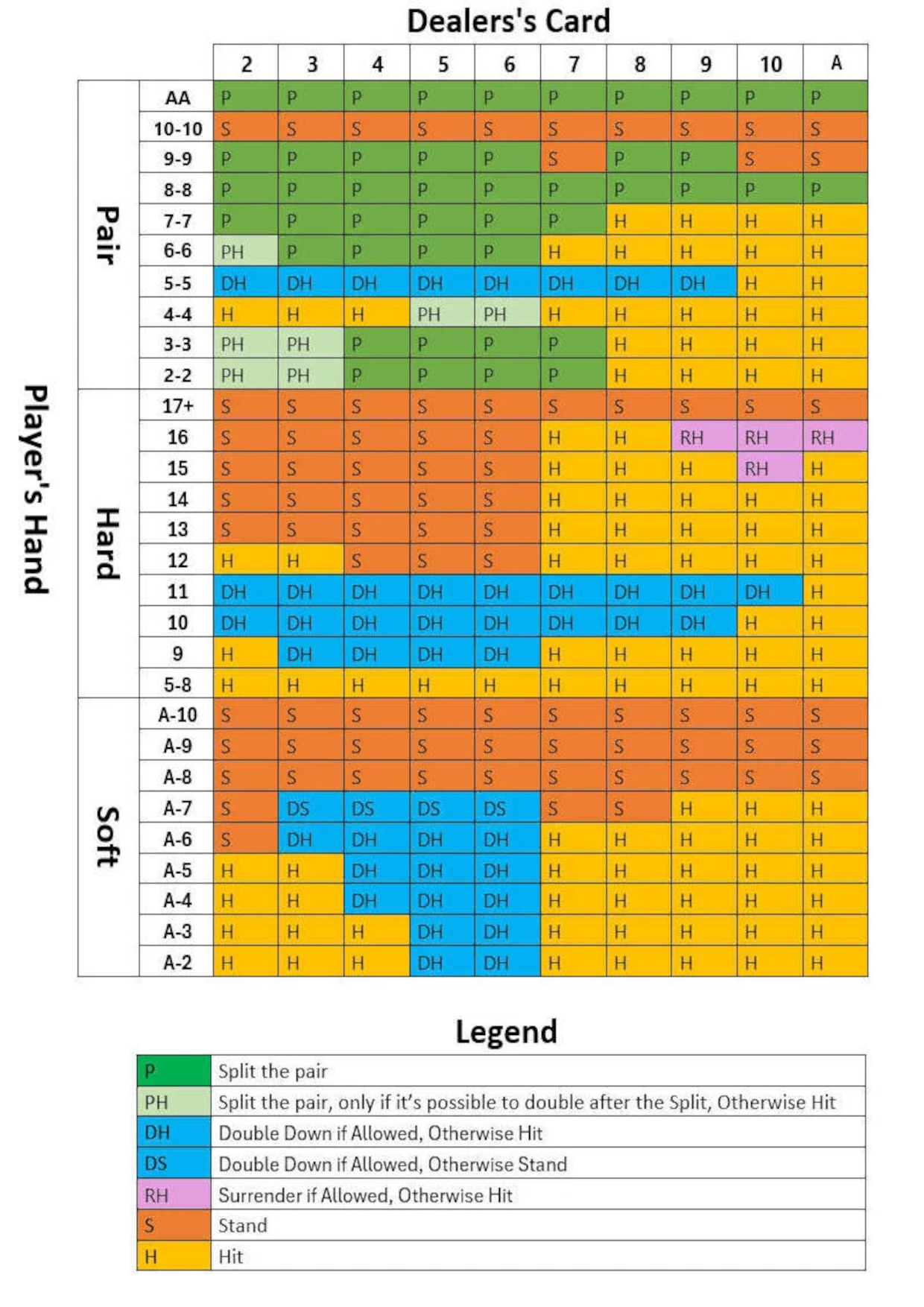
📊 The Math Behind the Chart
Blackjack charts tap into the DNA of probability and expected value to steer savvy play. Each option on the chart–hit, stand, double, or split hand–is supported by precise mathematics that considers risk, reward, and the dealer’s likely outcome.
Understanding basic blackjack strategy allows players to read the game, plan long-term, and avoid expensive errors.
🎲 Probability
Probability in Blackjack is about how likely it is that certain cards or hands will come up, and those likelihoods inform every decision. In the example, a hand of 12 is about 30% to bust by hitting.
Players can use basic math to calculate the likelihood of specific hands, such as drawing an Ace to create a soft 18 or a ten-value card to complete a solid hand. If you’re holding a soft 18, the probability of improving that hand is split: 1 out of 13 for getting a 19, 1 out of 13 for a soft 20, and so on, with 4 out of 13 odds of converting to hard 18.
Card counting techniques also rely heavily on probability and pattern tracking. Betting strategies rely on these probabilities, assisting manage risk and reward.
By consulting the odds prior to every move, players can determine whether to play it safe or roll the dice, making their decisions less about fortune and more about strategy.
💡 Expected Value
Expected value is the average outcome you’d receive if you repeated the same play multiple times in a blackjack game. In Blackjack, each move—hit, stand, double down—has a distinct expected value according to the probabilities and payout.
For instance, when considering doubling down, knowing whether it will yield a higher return than just hitting or standing is crucial. This fundamental approach, originally plotted in the 1950s, is based on mastering and understanding the basic blackjack strategy chart.
Players who check expected value before betting can identify the best long-term moves. If the payout for a blackjack is 3:2, the expected value of hitting one grows; if it’s 6:5, it drops.
By consistently thinking in terms of expected value, players can bypass bets that seem attractive but fail to yield good long-term results.
💸 House Edge
House edge is the casino’s mathematical advantage in Blackjack, typically displayed as a percentage of every bet. Lower house edge games equal good odds for you!
The house edge moves around depending on the rules—such as blackjack payout or number of decks—and how closely players adhere to basic strategy. An adherent to the chart can drive the house edge all the way down to under 1%.
Knowing the house edge allows players to choose tables that actually give them a chance. The lower the edge, the more value they receive from savvy play, such as card counting.
📋 How to Read a Blackjack Chart
A basic blackjack strategy chart provides an easy-to-read visual instruction for each player's hand and dealer upcard at the beginning of a hand. It guides you to play smart, minimize losses, and reduce the house edge.
Each chart is specific to the table rules, so be sure to watch out for house variations!
- Locate your hand value on the player’s side of the chart.
- Find the dealer’s upcard along the top row.
- Cross-check the two to see the suggested action.
- Use the legend to decode chart abbreviations and symbols.
- Implement tips (hit, stand, double, split) according to your table’s guidelines.
1. Locate Your Hand
Rapidly identifying your hand total is crucial for fluid play. Hard means you have no Ace, or the Ace counts as 1.
Soft hands are those with an Ace counted as 11, such as A-7 (soft 18). This is important because soft hands provide you with more choices – you can always hit without exploding.
Practice locating your hand on the chart. The more you complete, the quicker you progress.
You sidestep mistakes that chip away at your stack. For instance, confusing a hard 17 with a soft 17 results in the incorrect play.
So double-check your hand type first and foremost before proceeding.
2. Find the Dealer's Card
First glance at the dealer’s upcard, it defines your optimal action. Is it a low card (2–6) or a high (7–Ace)?
The weak dealer card gives you license to be daring, and the strong one cautions you to be conservative.
Understanding how the dealer’s upcard affects play keeps your decisions crisp. For instance, with a dealer 6, many charts will tell you to double down with an 11.
Remember the dealer's possible total for each round. ALWAYS link your move to what the dealer displays.
Charts are constructed around this logic, and missing it can disrupt your play.
3. Cross-Reference for Action
Cross-referencing refers to lining up your hand row and the dealer’s column on the chart, locating the corresponding action box where they intersect. For instance, if you have 10 and the dealer has 9, then the chart might say hit.
With a pair of 8s vs a dealer 6, for example, the chart will generally tell you to split.
Work on this step. It builds skill, it quickens decisions and it eliminates errors that can damage your probabilities.
With sufficient practice, you’ll identify the correct action in moments.
4. Understand the Legend
Each symbol and color code is described in the chart legend. H”=hit, “S”=stand, “Dh”=double (or hit if not allowed), “P”=split.
- Refer to the legend before every game. It prevents confusion and is time-efficient.
- If you gloss over the legend, you may misread the chart.
- Learn chart terms to play with confidence.
⚖️ Chart Variations and Rules
Blackjack charts are unique to each player. They vary according to the game’s rules, table configuration, and number of decks.
Knowing the difference is crucial for making the correct play at the table. The wrong chart can equate to missed opportunities or greater risk.
- Single-deck vs. multi-deck chart variations.
- Rules around doubling, splitting, and surrendering.
- Dealer stands or hits on soft 17.
- European Blackjack (no hole card rule).
- Different splitting rules for pairs.
Charts tell you when to hit, stand, double, or split, but you have to select a chart that matches your game. Each rule tweak alters the underlying math of optimal play.
Adjusting your play for house rules, number of decks, or the dealer’s actions is essential for sustained profitability.
🃏 Deck Count
The odds are impacted by the deck count. Single deck games facilitate card tracking and reduce the house edge. Multi-deck games, usually six or eight, drive the house edge higher.
Single deck allows you to employ more aggressive tactics, such as doubling down more frequently. Multiple decks lessen the probability of specific cards, thus you must be more judicious with splits or doubles.
For instance, splitting 8/8 in a single deck game is generally more favorable to the player than in an eight deck game.
Always verify the deck count prior to sitting. The more decks, the more the house edge expands.
Knowing this helps you finess your chart choice and playstyle for better results.
1️⃣7️⃣ Dealer's Soft 17
A soft 17 is any hand where the dealer’s total contains an ace valued at 11, such as ace-six. If the rules say the dealer hits on soft 17, it gives the house a slight advantage.
That is, you need to be more aggressive, particularly with hands like soft 18.
Dealers hitting soft 17 will pull more cards, altering their bust frequency. For players, it typically translates into doubling down more with soft hands.
If the dealer stands on soft 17, then it’s safer to stand with soft 18 or greater.
Notice this rule. Don’t forget to modify your plays if the dealer hits or stands on soft 17—it changes everything in your hand calculations!
🔢 Doubling Rules
When you double down in Blackjack, you double your bet and receive only one additional card. Some basic blackjack strategy charts recommend doubling on a hard 10 or 11 against a weak dealer card.
However, certain games, like the deck blackjack version, allow doubling only on 9, 10, or 11, known as the Reno rule. This limitation makes it more challenging to gain an advantage and increases the house’s edge.
If doubling after a split hand is not permitted, you may leave some strong hands on the table, raising the house edge by about 0.12%. In games that allow doubling on any two cards, blackjack strategy charts indicate more doubling options, giving you additional opportunities to win.
Always test what the table permits and play according to the basic blackjack strategy rules. Double only when your hand and the dealer’s upcard align for the optimal probability, ensuring you are using the correct strategy.
🏳️ Surrender Options
Surrender is laying down your hand early and receiving half of your wager back. This move is optimal when your probability of winning is very slim, such as with a hard 16 versus a dealer 10.
Employ surrender judiciously. It’s a clever way to cut your losses when the numbers tell you you’ll lose most of the time.
That is, unless you’ve got a table with surrender — not all tables offer it, so check before you play.
If you can give it up, put it in your chart and system. It’s one more instrument to keep your losses tamed.
🚀 Beyond Basic Strategy
To truly master blackjack, it takes more than memorizing a basic blackjack strategy chart. Players must adjust to different table rules and varying deck counts and observe how the dealer and other players behave to reach a break-even game.
Although understanding the rules of blackjack is crucial, applying advanced techniques can significantly lower the house advantage—sometimes to as little as 0.5%. Mastering concepts such as soft hands and the Illustrious 18 index plays is essential, but real mastery comes from practice and situational awareness.
➗ Splitting Pairs
Splitting pairs allows you to transform one hand into two, providing more opportunities to win or minimize losses. So the best hands to split are aces and eights, regardless of the dealers up-card.
If you receive two aces, splitting provides you with two chances at a powerhouse hand, as splitting eights gets you out of a damaging situation. On the flip side, splitting tens is a near universal ‘don’t’ because 20 is a great hand.
Splitting is something you want to practice. Splitting sixes against a dealer’s four through six ‘bumps’ the odds a bit in your favor, while splitting nines against a dealer’s seven has a better outcome than standing.
Making the right call on splits not only can inflate your payouts, but it can also help you control risk.
💵 Doubling Down
To double down is to double your bet for one additional card. It’s a key move when you’re sitting on 11, and the dealer reveals a weak card, like a six.
This is your opportunity to double your winnings if a face card comes up.
Be sure to check the rules on doubling down, as some tables restrict when you can do it. For example, soft 18 (A,7) should be doubled down on versus a dealer’s 2-6 but hit against a 9-A.
Knowing when to double down and how to double down gives you a stronger advantage over the house.
🛡️ Taking Insurance
Insurance bets are given when the dealer is showing an Ace. It’s a prop wager on whether the dealer has blackjack.
For the most part, insurance is mathematically a losing proposition for most players. A few pros take insurance some of the time — but only when they’re counting cards and know there is an abundance of tens remaining.
It’s all about counting the cost — relying on insurance too much will deplete your bankroll. Consider it a special-purpose tool, not a daily strategy.
🏆 Experience and Practice
- Mastering advanced strategies needs time.
- Practice, observe, and refine your skills.
- Adapt to table rules and player moves.
- Always look for games with the lowest house edge.
⚠️ Common Player Missteps
These basic blackjack strategy charts may help, but like a professional blackjack player, the quickest way to ruin a tool is to use it without understanding it. Misinterpreting, neglecting, or blindly adhering to blackjack rules can result in mistakes and lost opportunities.
Here are the most common player missteps and why recognition and adjustment count.
- Ignoring chart tips with hunches, like standing on a hard 17 or insuring, which are stupid plays that don’t work.
- Splitting tens, even with a hand total of 20, being one of the strongest hands to be dealt.
- Not splitting pairs like 2’s versus dealer 2-7, or 6’s vs 2-6, where you can maximize returns.
- Not doubling down on soft 17 with the dealer’s ace, particularly if the dealer hits soft 17.
- Smashing 13–16 vs. A dealer’s 2–6 when standing is usually optimal.
- Overlooking surrender 15 or 16 vs. 9–Ace
- Using your gut instead of a strategy which sabotages dependable play.
- Not giving yourself time to learn the chart’s logic, so you keep making the same mistakes.
🚫 Ignoring the Chart
- Higher likelihood of expensive errors, like standing when a hit is right, or vice versa.
- Greater likelihood of falling back on hunches, reducing consistency.
- Failed attempts to split, double down, or surrender according to best odds.
- Inconsistent, making it harder to accumulate skills.
Players should view the basic blackjack strategy chart as a roadmap for every choice. Consistent play builds habits that foster reliable victories and increased payouts in blackjack games.
🙈 Following It Blindly
BLIND CHART USE: This is the biggest and fussiest of all common player missteps. For instance, a couple of charts are customized for certain dealer rules, and using them blindly can backfire.
Key is critical thinking. Players have to adapt to varied rule sets, for example, when a dealer hits or stands on soft 17.
The result of treating the chart as a guide, not a code, is smarter play. Mixing chart smarts and common sense allows players to adapt to specific hands and dealer cards for improved results.
👐 Misplaying Soft Hands
Lots of players confuse soft hands with hard hands, resulting in errors such as failing to double down on soft 17 vs. A dealer’s Ace. Soft hands require a separate technique.
As the ace can have a value of either 1 or 11, these hands give you more space to play aggressively and capture the most value. Working on chart-supported soft hand strategies trains players to identify when to hit, stand or double, maximizing these adaptable hands and increasing winning percentage.
🎓 The Value of Learning
Chart use is an ongoing learning process. Players get better by looking back and learning from every game.
Adjustment and self-knowledge translate into more intelligent, more lucrative play. Mistakes are part of growth.
🔒 Conclusion
Blackjack charts deliver tons of bang for players looking to increase their odds at the table. Basic colors and numbers direct every decision.
When in doubt, check the chart, and players can identify the optimal move for any hand. Errors come down when you trust the math and stick to the fundamentals.
From new players to long time fans, people from all over utilize these charts. The key remains—know the rules, study the chart, and commit to obvious decisions.
To improve, keep the chart handy, play consciously, and record the outcome.
Frequently Asked Questions❓
What is a blackjack chart?
A basic blackjack strategy chart tells you which action to take in any given situation. It aids players in making mathematically informed decisions, increasing their odds of prevailing in the blackjack game.
How does a blackjack chart help players?
A basic blackjack strategy chart assists players by displaying the best play for every hand. This minimizes guesswork and errors, helping you make the right choices more often and reducing the house edge.
Are all blackjack charts the same?
No, blackjack strategy charts differ. The chart you utilize is dependent on the game’s rules, including how many decks are played with in the deck blackjack version and if the dealer hits or stays on a soft 17. So, always consult your game's specific basic blackjack strategy chart.
Is it legal to use a blackjack chart in casinos?
Using a basic blackjack strategy chart is legal in most casinos, as they rely on public information and do not constitute cheating. Always verify the casino's policy before bringing one to the blackjack table.
Can a blackjack chart guarantee a win?
No, a basic blackjack strategy chart won’t ensure a win. It just assists you in making the optimal plays in the blackjack game, as there’s still gambling involved, and losses can occur even with perfect strategy.
Do blackjack charts work online and in person?
Blackjack strategy charts are just as effective whether you engage in online blackjack or in brick-and-mortar casinos. It’s the blackjack rules that count, not the venue.
How do I read a blackjack chart?
To effectively utilize a basic blackjack strategy chart, locate your hand along one margin and the dealer’s card along the other. The chart indicates if you should hit, stand, double down, or split based on the card combination.
